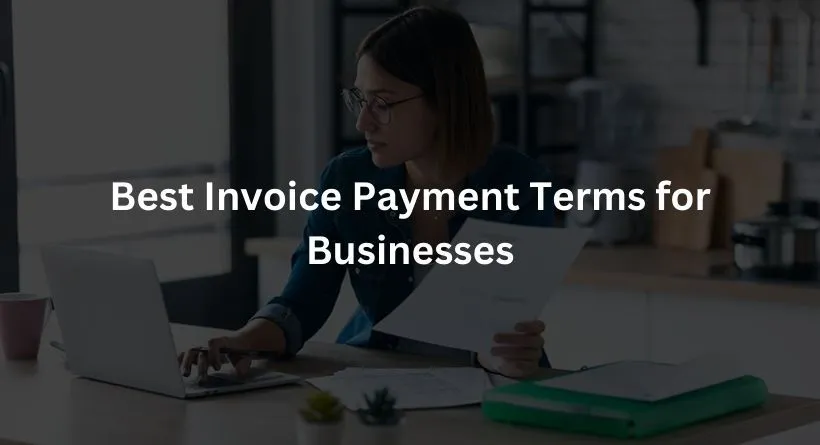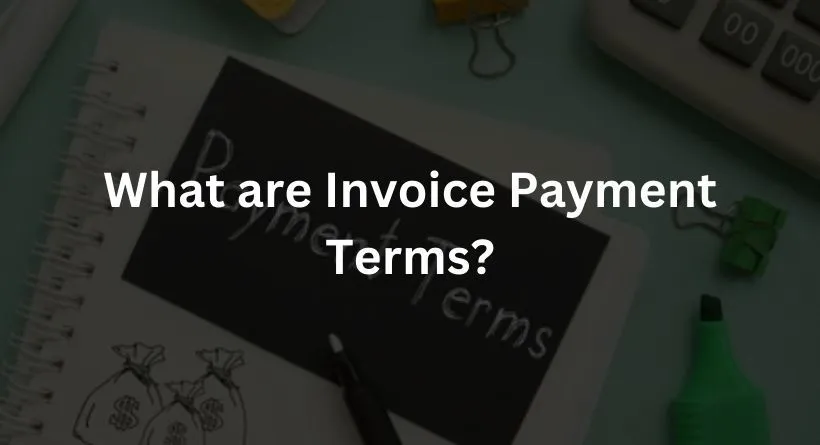All invoices that small businesses send to clients include payment terms that specify when they anticipate receiving payment for their services as well as the various payment options that clients may use. This gives businesses more control over their cash flow and enables them to budget for upcoming spending.
All invoices sent by small businesses to clients include invoice payment terms that specify how fast they anticipate receiving payment for their services and the various payment options that clients may utilize. Business owners may better manage their cash flow and prepare for future costs thanks to invoice payment periods.
What Are Payment Terms on an Invoice?
The payment conditions listed on an invoice allow customers of a business know how and when to make payments for the invoice. Businesses can pick from a variety of payment arrangements to add on their invoices. This article will assist you in comprehending the various terms for paying an invoice:
LATE FEES FOR UNPAID INVOICES
Ensure the enforceability of your invoice payment terms. Clients will be made aware of the possibility of additional fees for late payments if you include late fee restrictions in your invoice payment terms. According to a Fresh Books research, charging late fees benefits businesses by increasing the percentage of paid bills.
Typically, late fees for outstanding bills range from 1.5 to 3 percent interest each month. Verify that any late payment requirements you provide in your payment terms are compliant with state law. Learn what the highest yearly interest rate is in your state.
What Are the Best Invoice Payment Terms for Businesses?

The terms that get you paid the quickest are the ideal invoice payment terms for your company. The following are some recommendations regarding invoice payment terms:
1. POLITELY WORD YOUR INVOICE PAYMENT TERMS
Writing your invoice payment conditions in a courteous manner is not only a smart way to keep your client relationships strong, but it may also increase the likelihood that your bills will be paid. According to a Fresh Books research, when invoice payment conditions contain words like “please” and “thank you,” the proportion of paid invoices rises by 5%.
2. SET SPECIFIC DEADLINES
Your firm may obtain money more quickly if your payment conditions include clear, detailed deadlines. Payment terms for invoices that are ambiguous and complex, such as “Net 30” or “Payment due upon receipt,” may mislead clients and cause late payments. When describing your billing due dates, be specific. You may, for instance, include the precise due date like “Payment Due October 31, 2023.”
3. SHORTEN PAYMENT PERIODS
Your company should think about reducing the payment time on your invoices so that clients pay you more quickly. While a 30-day billing cycle was formerly the norm, technology has made it possible for customers to pay their bills much faster through online payments and direct transfers. To see whether it helps you get funds more quickly, try switching your payment term from 30 days to 21 days.
4. INCLUDE AND ENFORCE LATE FEES
Even modest late fees, like 2% interest per month, might provide as an additional incentive for customers to pay their invoices on time. Just be sure to be transparent with them about your late charge policy and to be kind but strong when enforcing the fines.
What Payment Methods Should I Accept?
Small companies should accept as many different forms of payment as they can from customers in order to be accommodating and speed up payment. When you provide customers a choice of payment options on your invoice, they are more likely to pay you quickly because they may select the option that best suits their needs. The following are some popular payment options that your company could consider accepting:
- Cash Check
- Visa, MasterCard, and American Express are among the credit cards.
- Online transactions
- Cellular payments
- Other cryptocurrencies, such as bitcoin
How to choose invoice payment terms for your business

It’s important to conduct thorough research on your customer’s payment history, industry norms, and how your business functions before deciding on the payment terms for your company. Here are some things to think about as you try to strike a balance between retaining customers and keeping a positive cash flow.
Analyze customer’s credit history
It can be simple to administrate and manage to establish uniform payment terms for all consumers. However, it is important to evaluate each client separately based on certain factors like the length of time they have been doing business with you and the maturity of their company.
New clients wouldn’t have a history with your company to evaluate their trustworthiness and demand shorter payment terms than dependable, dependable clients who would merit longer periods. The next query should be if the client has a track record of paying bills on time. Even with long-standing clients, if their payment history is questionable, you might wish to set shorter deadlines, ask for a down payment, or, as a last option, impose late payment fines. Shorter payment periods could be impractical for complicated, long-term projects; instead, think about taking milestone payments.
You May Also Like Reading: How to Start a Food Truck Business
Consider your cash flow needs
Small business owners face several costs, including paying for utilities, vendors, and staff as well as investing in innovative ways to grow the company. In this situation, it is essential to monitor your cash flow requirements before choosing the payment terms that would benefit both your company and your clients. If a major client didn’t make their payment on time, you need to think about what payment conditions wouldn’t impact your working capital and disrupt your regular business operations. For instance, you might be able to adjust your invoice payment terms to Net 30 or even Net 15 to maintain optimum cash flow if your vendor invoices and other costs are due every month.
Align with industry expectations
You might wish to research the common invoice phrases used in your business before establishing your payment terms to get a sense of what your consumers would be accustomed to. For instance, firms selling commodities would anticipate payment within a few days at most or Cash on Delivery, but the usual payment period in the construction sector, where delays and change orders might be expected, is 60 days or more. In contrast, a tech consultant may work for their client on a retainer for a month and set a payment term of Net 30, while in the manufacturing sector, the net terms may range from Net 30 to Net 120. The key lesson is to make sure that your invoice payment terms adhere to industry norms to prevent deviating too far from client expectations and running the risk of getting late payments and confusing them.
Conclusion
When selecting your invoice payment terms, much is on the line. They have an impact on your company’s finances and set the tone for your engagement with consumers going forward. When determining what invoice terms to give, you should consider the client’s payment history as well as the potential income the task may generate.
FAQs
What are standard payment terms for invoice?
What are the typical conditions of payment? Standard payment terms specify the typical payment intervals for your clients and might differ dependent on your company’s location, what is deemed “normal” in your particular sector or industry, and the credit terms you feel comfortable establishing with clients.
What terms and conditions should I put on my invoice?
Simply said, all that the consumer needs to know about the payment should be included in your invoice payment conditions. This might also include late fines, other trade discounts, monetary incentives for early payment, and deposit details.
How do you write payment options on an invoice?
The payment methods you accept (such as Direct Debit, bank transfer, check, etc.) and the currency you like to be paid in are specified in your invoice’s payment conditions. You should also mention any potential late-payment penalties you might have in place, as well as the anticipated due date for the payment.

